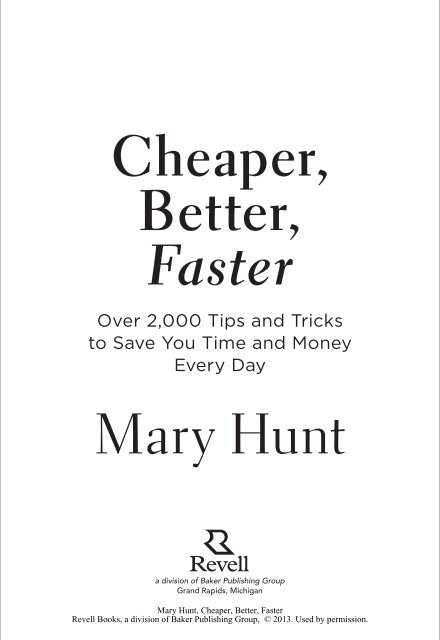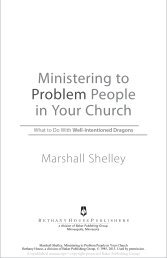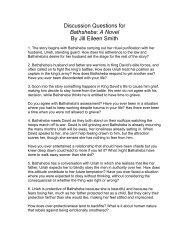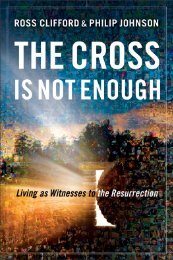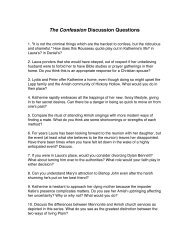Cheaper, Better, Faster Mary Hunt - Baker Publishing Group
Cheaper, Better, Faster Mary Hunt - Baker Publishing Group
Cheaper, Better, Faster Mary Hunt - Baker Publishing Group
Create successful ePaper yourself
Turn your PDF publications into a flip-book with our unique Google optimized e-Paper software.
<strong>Cheaper</strong>,<strong>Better</strong>,<strong>Faster</strong>Over 2,000 Tips and Tricksto Save You Time and MoneyEvery Day<strong>Mary</strong> <strong>Hunt</strong>O<strong>Mary</strong> <strong>Hunt</strong>, <strong>Cheaper</strong>, <strong>Better</strong>, <strong>Faster</strong>Revell Books, a division of <strong>Baker</strong> <strong>Publishing</strong> <strong>Group</strong>, © 2013. Used by permission.
© 2013 by <strong>Mary</strong> <strong>Hunt</strong>Published by Revella division of <strong>Baker</strong> <strong>Publishing</strong> <strong>Group</strong>P.O. Box 6287, Grand Rapids, MI 49516-6287www.revellbooks.comPrinted in the United States of AmericaAll rights reserved. No part of this publication may be reproduced, stored in a retrievalsystem, or transmitted in any form or by any means—for example, electronic,photocopy, recording—without the prior written permission of the publisher. Theonly exception is brief quotations in printed reviews.Library of Congress Cataloging-in-Publication Data is on file at the Library of Congress,Washington DC.ISBN 978-0-8007-2144-2 (pbk.)Published in association with the literary agency of The Steve Laube Agency, 5025N. Central Ave., #635, Phoenix, Arizona 85012-1502.The internet addresses, email addresses, and phone numbers in this book are accurateat the time of publication. They are provided as a resource. <strong>Baker</strong> <strong>Publishing</strong><strong>Group</strong> does not endorse them or vouch for their content or permanence.13 14 15 16 17 18 19 7 6 5 4 3 2 1<strong>Mary</strong> <strong>Hunt</strong>, <strong>Cheaper</strong>, <strong>Better</strong>, <strong>Faster</strong>Revell Books, a division of <strong>Baker</strong> <strong>Publishing</strong> <strong>Group</strong>, © 2013. Used by permission.
ContentsIntroduction 71. Automobiles 112. Cleaning 333. Clothing and Accessories 674. Food and Cooking 835. Gifts 1336. Health and Beauty 1597. Holidays and Special Occasions 1778. Home 2139. Kids and Babies 25510. Laundry 27111. Money and Finances 28512. Outdoors and Garden 31513. Pets 33514. Repairs and Maintenance 34115. Shopping 35916. Travel and Entertainment 3755<strong>Mary</strong> <strong>Hunt</strong>, <strong>Cheaper</strong>, <strong>Better</strong>, <strong>Faster</strong>Revell Books, a division of <strong>Baker</strong> <strong>Publishing</strong> <strong>Group</strong>, © 2013. Used by permission.
<strong>Mary</strong> <strong>Hunt</strong>, <strong>Cheaper</strong>, <strong>Better</strong>, <strong>Faster</strong>Revell Books, a division of <strong>Baker</strong> <strong>Publishing</strong> <strong>Group</strong>, © 2013. Used by permission.
IntroductionI didn’t actually set out to become a tip aficionado. But that’sexactly what’s happened since the day I began publishing Debt-Proof Living newsletter (formerly Cheapskate Monthly) and invitedreaders to share with me their best money- and time-saving tips.Three or four fascinating tips came pouring in those first fewmonths (two or three more than I expected), and because they weregreat, I shared them with my readers. The more tips I publishedin subsequent months, the more readers responded with new andbetter tips. In time, I began to go out of my way looking for tipsand was amazed at how many turned up. I’m not sure if I wasmore attracted to the tips or the tips to me (sometimes I feel like atip magnet), but the result was clear: I loved tips. I can read a tip,digest it quickly, mentally file it for future use, move on to the nextone, and never get bored.Before long, tips began arriving at my office faster than I couldfigure out what to do with them. I couldn’t throw them away. Andbecause of the way they arrived (and still do)—printed on napkins;buried in the recesses of long, detailed letters; salvaged on snippetstorn from newspapers; phone, fax, and email messages—I had alogistical challenge from the very start.7<strong>Mary</strong> <strong>Hunt</strong>, <strong>Cheaper</strong>, <strong>Better</strong>, <strong>Faster</strong>Revell Books, a division of <strong>Baker</strong> <strong>Publishing</strong> <strong>Group</strong>, © 2013. Used by permission.
IntroductionI was able to stick with a simple filing system for about threedays until I discovered a much easier method: piling—which tookhardly any time at all. And then piles began to grow and spill intoeach other at an unprecedented rate into what I would eventuallyname Mt. Tip.I knew I was headed for trouble the day I spent hours searchingfor one wonderful tip I knew was in there somewhere. And thatwas the day I conceded that I had to either find a way to movemountains or call a rubbish-removal contractor. I couldn’t go onliving like this.First published in 1997 under the title Tiptionary, this bookwas a big hit. Apparently I wasn’t the only one who loved handytips! Readers told me that reading the book was a lot like beingfaced with a bag of potato chips: It was almost impossible to stopwith just one tip.In the years since Tiptionary was released, the world has changeda lot! And that meant this book needed a radical update to make itcurrent. Sections on banking, computers, and travel, for example,needed overhauls.Enter Revell Books. All I had to do was mention the availabilityof a really awesome collection of handy tips to my editor, VickiCrumpton, and the best publishing team in the world was mobilizedinto action.What you have here is a revised and updated, fabulously funcollection of tips—short, to-the-point suggestions for ways to dothings cheaper, better, and faster. Many of these tips are timeless;others we know were current and relevant five minutes ago, butwho knows about next month!Some of the best tips you will read have completely unknownorigins because they’ve been passed from generation to generation,and someone along the line sent them my way. Some tipswere left out because they turned out to be nothing more thanmyths—legends people believe with all their hearts, but when putto the test, fail.8<strong>Mary</strong> <strong>Hunt</strong>, <strong>Cheaper</strong>, <strong>Better</strong>, <strong>Faster</strong>Revell Books, a division of <strong>Baker</strong> <strong>Publishing</strong> <strong>Group</strong>, © 2013. Used by permission.
IntroductionOne rejected tip had to do with bread and wallpaper. No foolin’.The tip was to discard the crust from a piece of bread, wad it upinto a tight dough ball, and use it like an eraser to clean dirt andmarks from wallpaper. I tried it and “erased” with all my might, butthat little dirty spot on my wallpaper would not budge. I threw thebread ball in the trash, grabbed a bottle of laundry stain remover,and took care of the smudge in a flash.Some entries were discovered quite by accident. I think of thewoman who wrote to me so excited because she no longer neededto scrub the toilet on Saturday since her husband had started dumpinghis denture-soaking liquid into the commode each morning.Bingo! A great household tip (page 63).Surely there’s a long story that goes along with the tip thatarrived on a postcard without a return address or signature, simplya postmark from somewhere in Alaska: “Have your head examinedbefore you attempt to build your own home. Unless youare a developer or professional contractor, you are in for a fewsurprises, not the least of which is that it will take twice as longas promised and cost twice as much as estimated.” There you go,for what it’s worth.The criteria for whether a tip made it into this collection werefairly simple: If it didn’t insult my intelligence, included a reasonableexpectation that it saved time or money, and prompted a responseanything close to Wow! What a great idea!—it was in. Thismeans you won’t be reading any tips that tell you to brush and flossyour teeth, because we’re smart and we already know we shoulddo that every day. But floss a turkey? Now that’s a great tip (page125). Or floss that winter coat? You’ll be glad you did (page 69)!You’re about to learn that there are many different ways to accomplishgoals. And that’s good, because if you need to polish thecopper in your kitchen and you don’t have any lemons on handbut you do have a jug of vinegar, you’ll be able to get the job donewithout running to the store to spend money needlessly (page40). When there’s more than one way to achieve the same result,<strong>Cheaper</strong>, <strong>Better</strong>, <strong>Faster</strong> will give you the choices.9<strong>Mary</strong> <strong>Hunt</strong>, <strong>Cheaper</strong>, <strong>Better</strong>, <strong>Faster</strong>Revell Books, a division of <strong>Baker</strong> <strong>Publishing</strong> <strong>Group</strong>, © 2013. Used by permission.
IntroductionAnd now to answer the question you will ask if you haven’talready: No, I do not do everything recommended in <strong>Cheaper</strong>,<strong>Better</strong>, <strong>Faster</strong>. There’s not a person on the face of the earth, myselfincluded, who could do all of these things in a single lifetime, norwould I want to. Some of the tips are just not applicable to my life.And some won’t apply to your life, either.Think of <strong>Cheaper</strong>, <strong>Better</strong>, <strong>Faster</strong> as a grand smorgasbord loadedwith every kind of delicacy you can possibly imagine—even somethings you can’t. As you pass by, look at everything, consider mostthings, and fill your plate with what suits your taste.The best thing about <strong>Cheaper</strong>, <strong>Better</strong>, <strong>Faster</strong>, just like your favoritesmorgasbord, is that you can come back again and againand again!<strong>Mary</strong> <strong>Hunt</strong>California201310<strong>Mary</strong> <strong>Hunt</strong>, <strong>Cheaper</strong>, <strong>Better</strong>, <strong>Faster</strong>Revell Books, a division of <strong>Baker</strong> <strong>Publishing</strong> <strong>Group</strong>, © 2013. Used by permission.
1AutomobilesAccident preparednessCarry a camera, pad of paper,and pen in the glove box ofyour car. In case of an accidentyou’ll have what you needto collect information and takeon-the-spot photos even if youhave left your cell phone witha camera in it at home. Be sureto draw a map and record allthe details while they are stillfresh in your mind.Air-conditioning vs. openwindows—4/40 ruleNot sure whether it’s morecost-effective to use theair-conditioning or open thewindows? Rule of thumb:If you’re driving under 40mph, open all four windowsand turn off the airconditioning.Over 40 mph,close the windows and run theair-conditioning.Battery terminal—cleanupPour club soda or Windex onthe battery terminals. It’s agreat way to quickly clean andneutralize the acid residue atthe battery terminals. Rememberto disconnect the batterybefore cleaning.11<strong>Mary</strong> <strong>Hunt</strong>, <strong>Cheaper</strong>, <strong>Better</strong>, <strong>Faster</strong>Revell Books, a division of <strong>Baker</strong> <strong>Publishing</strong> <strong>Group</strong>, © 2013. Used by permission.
<strong>Cheaper</strong>, <strong>Better</strong>, <strong>Faster</strong>Battery terminal—protectionA car’s starting problems arefrequently related to corrodedbattery terminals. Clean thebattery terminals occasionallywith a paste of baking sodaand water, and then reduce thecorrosion problem by smearingthem with a thin coatingof petroleum jelly. Rememberto disconnect the battery beforecleaning.Brakes—replacementHave your brakes replacedbefore the rotors have to beturned. You’ll save hundredsof dollars. Your mechanicshould check for free and tellyou how much of the pad isremaining. Don’t push it past5 percent.Brakes—when stopped on a hillWhen stopped on a hill, alwaysuse your parking or footbrake to hold the car still.Don’t hold it by applying gasto the accelerator or, in thecase of a standard transmission,by riding the clutch andapplying gas. These bad habitsaccelerate wear of the engine,clutch, and transmission.Use your brakes. That’s whatthey’re for.Bumper sticker removalRemove a decal or bumpersticker by first softening theadhesive with a hair dryer. Usea medium-heat setting for afew seconds until the adhesivesoftens and the sticker startsto peel. Continue with theheat until the entire stickerpeels off easily.Buyer consideration—costguide for any carFind out what it will cost toown a particular vehicle atwww.IntelliChoice.com. Partof Motor Trend Automotive<strong>Group</strong>, IntelliChoice evaluatesdepreciation, gas consumption,insurance costs, andfrequency of repairs to derivethe average five-year cost ofoperating each car.12<strong>Mary</strong> <strong>Hunt</strong>, <strong>Cheaper</strong>, <strong>Better</strong>, <strong>Faster</strong>Revell Books, a division of <strong>Baker</strong> <strong>Publishing</strong> <strong>Group</strong>, © 2013. Used by permission.
AutomobilesBuyer consideration—currentvs. new car operating costsKeeping your old car insteadof buying a new one can saveyou a lot of money over theyears. Example: A four-yearold,four-door American sedandriven fifteen thousand milesper year on average will costabout half of what a new carwill cost to operate over thatsame four-year period.Buyer consideration—insuranceCheck insurance rates beforeyou make a decision to purchasea particular car. Callyour agent with a couple ofchoices and get quotes.Buyer consideration—oldercar with low mileageOld cars with relatively lowmileage are choice buys. Agepushes the value down, but themileage is more representativeof the vehicle’s true age. Aproperly maintained car withfifty thousand miles on it islikely to have the same kickwhether it is three years old oreight. The eight-year-old car,however, will be much cheaper.Buyer consideration—safest colorsIn the market to purchasea car? Insurance actuarialssay that if you’re interestedin safety, you should drive agreenish-yellow car to avoidbeing hit accidentally by anothervehicle. The next safestcolors are cream, yellow, andwhite—in that order. Theleast-safe colors are red andblack. Light-colored, singletonecars stand out from theirsurroundings, making themeasier to see and avoid.Buyer consideration—warranties transferable?If the seller says the vehicleis still under the originalmanufacturer’s warranty orany dealer service contract,double-check that these benefitscan be transferred fromthe original owner. Take noone’s word for it—read thecontracts.13<strong>Mary</strong> <strong>Hunt</strong>, <strong>Cheaper</strong>, <strong>Better</strong>, <strong>Faster</strong>Revell Books, a division of <strong>Baker</strong> <strong>Publishing</strong> <strong>Group</strong>, © 2013. Used by permission.
<strong>Cheaper</strong>, <strong>Better</strong>, <strong>Faster</strong>Buyer negotiation—contract scrutinyBefore signing a final auto purchaseor lease agreement, checkit with a magnifying glass. Thefolks who write up the finalagreement often make mistakes.Occasionally the agreeduponprice gets listed incorrectly,or extras you crossed offget added back in, or a higherfinancing charge than the oneyou settled on finds its wayback into the deal. Give thecontract a brutal examination.Buyer negotiation—dealer add-onsFactory-installed options aregood buys, but think twiceabout any option the dealerwants to add, such as a stereoor sunroof. Typically, specialtyshops do better work andcharge half the price.Buyer negotiation—dealeroption, rust-proofingRust-proofing as a dealer optionis not advisable. Cars arerust-proofed at the factory,and unless you live in an areathat goes heavy-duty on thewintertime salt, contemporaryautomobiles don’t need extraprotection. It isn’t uncommontoday to find new cars comingwith five-, seven-, or even tenyearrust protection warranties.In many cases this optionwill invalidate any rust warrantythat came with the carfrom the manufacturer.Buyer negotiation—dealeroption, upholstery protectionThe dealer fabric protectionoffered as an option whenpurchasing or leasing an automobileamounts to a can ofScotchgard sprayed on the upholstery.Save money by skippingthe option, picking up acan of Scotchgard, and doingit yourself.Buyer negotiation—don’tdivulge bottom lineDon’t tell a dealer you canafford, say, a $300 monthlypayment. If you tell him, he’llgladly increase the interest rateor lengthen the terms until itexactly matches what you canafford. Either way, you lose.14<strong>Mary</strong> <strong>Hunt</strong>, <strong>Cheaper</strong>, <strong>Better</strong>, <strong>Faster</strong>Revell Books, a division of <strong>Baker</strong> <strong>Publishing</strong> <strong>Group</strong>, © 2013. Used by permission.
AutomobilesBefore you go car shopping,figure out what you can afford,but don’t reveal it at the dealership.And negotiate for the lowestinterest rate you can get too.Buyer negotiation—get it in writingIf you want something fixed onthe car you are buying, get it inwriting the moment it is offeredor agreed upon. Do not expectthe dealer to pay for somethingyou didn’t get in writing.Buyer negotiation—point by pointWhen shopping for a car, negotiateone point at a time: theprice of the car, then the dealeradd-ons you want eliminated,the trade-in value of a used car,then financing. If you try tocover all these points at once,you’ll be so thoroughly confusedyou’ll lose your leverage.Buyer negotiation—willing to walk awayAs a consumer, one of yourgreatest strengths when negotiatingto buy a new car isyour willingness to walk awayfrom it. Unless a salespersonbelieves you will walk away,you are not likely to get thebest deal.Buyer’s Guide stickerIf you are considering buyinga used car from a dealer, becomefamiliar with the Buyer’sGuide sticker posted on everyused car offered for sale (forsale-by-ownercars excluded).It was originated by the FederalTrade Commission (FTC)as a consumer protection device.Download the ConsumerBuyer’s Guide from the FTCwebsite at www.FTC.gov.Cleaning—aluminum mag wheelsIf your car has aluminummag wheels, check with themanufacturer to see if theyare protected by a clear-coatfinish. If yours are protected,as most are, do not use abrush to scrub them. This willscratch the clear coat and givethe wheels a fuzzy look insteadof the brilliance you paid for.Use only a mild, nonabrasivecleaning wax or polish.15<strong>Mary</strong> <strong>Hunt</strong>, <strong>Cheaper</strong>, <strong>Better</strong>, <strong>Faster</strong>Revell Books, a division of <strong>Baker</strong> <strong>Publishing</strong> <strong>Group</strong>, © 2013. Used by permission.
<strong>Cheaper</strong>, <strong>Better</strong>, <strong>Faster</strong>Cleaning—bugs off windshieldTo remove stubborn bugresidue from a windshield,sprinkle the surface with bakingsoda and scrub gently witha wet sponge.Cleaning—chromeBriskly scrub rust spots oncar bumpers with a piece ofcrumpled aluminum foil, shinyside out. (This tip also workswell on the chrome shafts ofgolf clubs.)Cleaning—floor matsSome carpet floor mats willfit into your home washingmachine and come outreally clean after a wash inwarm water with mild detergent.Spread them out flat toair-dry.Cleaning—tar and tree sapA little dab of butter, margarine,or even mayonnaise isgreat for removing unhardenedsap or tree pitch from the surfaceof your car.Cleaning—tiresA paste made of Bar KeepersFriend (a household cleaneravailable in most stores) andwater works well to clean tires.Spread it on and allow to sitfor about 10 minutes. Rinse.This works as well as specialwhitewall cleaner, but for afraction of the cost.Cleaning—vinyl dashboardand upholsteryClean a car’s vinyl upholsterywith a damp cloth dipped inbaking soda. Follow with amild solution of dish-washingliquid and water. Rinsethoroughly.Cleaning—wax marksCar wax can be removed fromautomobile trim with ammoniathat has been carefullyapplied with a rag or a cottonswab.Cleaning—windshield wiper bladesBefore you toss out thosewindshield wiper blades, clean16<strong>Mary</strong> <strong>Hunt</strong>, <strong>Cheaper</strong>, <strong>Better</strong>, <strong>Faster</strong>Revell Books, a division of <strong>Baker</strong> <strong>Publishing</strong> <strong>Group</strong>, © 2013. Used by permission.
Automobilesthe rubber part with rubbingalcohol. You may be pleasantlysurprised to find theywere not worn out at all—justgunked up.Clutch firstOn standard or manual-shiftcars, get into the habit ofalways pushing in the clutchbefore starting the engine,whether or not the car is ingear. Besides being an obvioussafety practice, holdingthe clutch in while starting theengine lets it turn over just abit more easily, lessening thepower required from the batteryand starter motor.Condensation on windowsTo take care of the condensationthat builds up on theinside of car windows duringthe cold winter months, leavethe air-conditioning on withthe temperature in the heatposition and windows willclear like magic. Or carry anordinary chalkboard eraser inthe car. Simply erase away thecondensation.Coolant, alwaysAlways keep a mix of equalparts antifreeze and water inyour car’s cooling system, evenif you live in a mild climatewhere it never freezes. Notonly does antifreeze keep yourcooling system functioningwell, it also contains valuablerust inhibitors.Crime—avoid being followedA great way to avoid a possiblecarjacking is to be aware ofwhat’s going on around you.If you think someone is followingyou, make four rightturns, which will in essencehave you driving in a circle. Ifthat suspicious car makes thesame turns, immediately driveto the nearest police station,busy store, or service stationto seek help.Crime—cars thieves shunChoose a car not coveted bycriminals. A phone call to yourlocal police department willreveal which cars are mostlikely to be stolen in your area.17<strong>Mary</strong> <strong>Hunt</strong>, <strong>Cheaper</strong>, <strong>Better</strong>, <strong>Faster</strong>Revell Books, a division of <strong>Baker</strong> <strong>Publishing</strong> <strong>Group</strong>, © 2013. Used by permission.
<strong>Cheaper</strong>, <strong>Better</strong>, <strong>Faster</strong>Crime—parking habitsmake a differenceA car that’s parked in thesame place for the sameamount of time each day andnight lets thieves know whereto look for it, and this givesthem plenty of time to figurehow much time they’d need tomake off with it.Crime—registration locationNever leave your car registrationin the glove compartment.It gives a car thief automaticproof of ownership. Keep itwith you.Dealer repairs to avoidNeed a brake job, muffler repair,or front-end alignment?Head for shops specializing inthese jobs. They offer lowerprices than dealers, and pollsshow they deliver better customersatisfaction.DeodorizerTo keep your car smellingfresh, put some of yourfavorite potpourri in a meshbag and tuck it under thefront seat. No more danglingpine trees from your rearviewmirror.Dipstick readabilitySave the guesswork whenchecking your car’s oil bymaking the dipstick easierto read. Drill tiny holes atthe lines that read “full” and“add” so they’ll never getobliterated.Driving—automatictransmission shiftingGive your automatic transmissiona little break by learninghow to help it shift. Ease upslightly on the acceleratorwhen you feel the transmissionbegin its shift. This increasesengine vacuum and helps thetransmission into a smooth,effort less shift.Driving—don’t downshiftIf your car is a stick shift,don’t downshift as a standardalternative to braking.18<strong>Mary</strong> <strong>Hunt</strong>, <strong>Cheaper</strong>, <strong>Better</strong>, <strong>Faster</strong>Revell Books, a division of <strong>Baker</strong> <strong>Publishing</strong> <strong>Group</strong>, © 2013. Used by permission.
AutomobilesDownshifting uses more gasand wears out the clutch andtransmission. Generally it’scheaper to replace worn brakesthan a worn clutch.Driving—don’t useoverdrive or fifth gearDon’t use overdrive or fifthgear until the car has warmedup sufficiently—approximately10 minutes under normal drivingand weather conditions.The rear axle and transmissionfluids must be adequatelywarmed for these units towork properly and efficiently.Driving—hands off the gearshiftDon’t drive with your handresting on the gear shift. Itmay feel good, but it adds unnecessarywear to the transmissionselector forks.Driving defensively—asif driving for fiveDrive for five drivers: yourself,drivers in front, drivers at bothsides, and the driver behindyou. Be prepared at all timesfor at least four of them to dothe unexpected.Driving left-footedIf your car has an automatictransmission, you may betempted to brake with yourleft foot. Bad habit. Leftfootedbraking leads to ridingthe brakes, which results in aslew of problems: poor gasmileage, reduced engine life,and worn brakes.Driving shoesKeep a pair of driving shoes inthe car. Sharp heels and sportshoes wear holes in the carpet.Use a carpet sample or remnantunder the pedals to prolong thelife of your vehicle’s carpet.Driving too slowlyDon’t poke along in city driving.The slower you go doesn’tmean the slower the car willwear. Actually the opposite istrue. Slow driving costs youmiles per gallon and increasesengine deposits. Keep your cityspeed in the economical 35 to19<strong>Mary</strong> <strong>Hunt</strong>, <strong>Cheaper</strong>, <strong>Better</strong>, <strong>Faster</strong>Revell Books, a division of <strong>Baker</strong> <strong>Publishing</strong> <strong>Group</strong>, © 2013. Used by permission.
<strong>Cheaper</strong>, <strong>Better</strong>, <strong>Faster</strong>45 mph range when possible.Most cars reach their maximummileage potential in thisrange, so this practice not onlyensures top miles per gallon inthe city but also promotes longerengine life.Engine care—avoidsuper-short drivesYou drive home and leave thecar parked out front. Later youput it away for the night bystarting the engine and puttingit in the garage. Because 90 to95 percent of engine wear occursin the first 10 seconds afterstarting the engine and beforethe engine becomes fully lubricated,that start-up and shortdrive into the garage causes theequivalent of 500 miles of mechanicalengine wear.Engine care—no revvingDo not race your engine outof gear or in neutral. Revvingan engine while the car is notmoving can only do harm; itwill never help. Many peoplelike to rev the engine a fewtimes just before putting itto bed. The old theory heldthat the extra revs pumpedextra oil through the cylinderwalls and made the next starteasier. Actually, the oppositeis true. Those high rpmsallow unburned fuel to dilutethe oil, wash away protectivecylinder coatings, and contributeto sludge buildup and oilcontamination.Engine care—park on pavementTry to always park on pavement,even at home. Don’tpark in the alley when you canpark on the paved street. You’dbe surprised how much dirtand dust can be sucked intoyour car’s engine compartmentwhen it is parked in dustyareas. Abrasive wear caused bygrit, dust, and dirt is one of themajor causes of engine failure.Keep away from dirt and dustproducingareas, and you willenhance your car’s longevity.Engine care—short tripsin cold weatherIf at all possible, don’t takeyour car on short trips of less20<strong>Mary</strong> <strong>Hunt</strong>, <strong>Cheaper</strong>, <strong>Better</strong>, <strong>Faster</strong>Revell Books, a division of <strong>Baker</strong> <strong>Publishing</strong> <strong>Group</strong>, © 2013. Used by permission.
Automobilesthan five miles on days whenthe temperature is belowfreezing. Really cold weathercan affect the pressure, plugs,and oil, and short trips don’tallow the engine to warmproperly. If a bus is available,take it, or if you can accomplishyour goal with the telephoneor internet instead ofgoing in person, do it.Engine care—unplugelectrical devicesUnnecessary use of electricaldevices, such as headlightsin the daytime (unless requiredfor safety), or anythingplugged into the cigarettelighter like a cell phone, hairdryer, curling iron, or electricrazor will actually make anengine work harder by makingit more difficult to turn thealternator.Fan belt emergencyPantyhose can come throughas an emergency fan belt ifyour car’s fan belt breaks. Cutaway the panty portion andtwirl both legs into a rope.Then wrap the strong nylonrope around your car enginepulleys, tie your best knot,and cut off the loose end. Startyour car and drive slowly forseveral miles to a gas station orphone or other sources of help.Gadget caddyA large handbag or other kindof handled tote with manyzippered compartments makesa dandy storage system forthe trunk of your car. Fill thepockets with battery cables, aflashlight, a first-aid kit, maps,window cleaner, paper towels,and a plastic window scraper.Gas cap replacementHave you ever left your gascap at the service station? Youwon’t be surprised to knowthat many others have too.The next time you’re capless,ask the station attendants ifyou might look through theirlost-and-found gas cap assortment.You’re sure to find onethat fits, and they’ll be happyto have you take one off theirhands.21<strong>Mary</strong> <strong>Hunt</strong>, <strong>Cheaper</strong>, <strong>Better</strong>, <strong>Faster</strong>Revell Books, a division of <strong>Baker</strong> <strong>Publishing</strong> <strong>Group</strong>, © 2013. Used by permission.
<strong>Cheaper</strong>, <strong>Better</strong>, <strong>Faster</strong>Gas fill-up—make itWednesday morningsOn average, Wednesday is thecheapest day to buy gas andthe earlier in the day, the better.Many station owners waitto see their competitors’ pricesto make their own adjustments.While this is not alwaystrue, consistently buying gason Wednesday mornings hasbeen shown to minimize theprice you’ll pay over time.Every little bit helps.Gas grade—go with whatis recommendedMake sure you use the octanegrade gasoline recommendedin your car owner’s manual.Using a more expensivehigher-octane gas than recommendedwill deliver no benefit,and a lower-octane gas thanrecommended could damagethe engine.Gas mileage—betterwith an empty trunkDon’t carry more than youneed. A light load resultsin much better gas mileage.Clean out heavy items fromthe trunk, and leave only thespare tire and safety equipment.Don’t make your car amobile warehouse for stuff youcan just as easily leave in thegarage.Gas mileage—betterwith turns on redSave gasoline and contributeto the long life of your car’sengine by taking advantage of“right turn on red” laws. Aftercoming to a complete stop,if the way is clear, turn righton that red light and keepmoving. Unnecessary idlingtime spent at red lights wastesyour fuel and that of the carsbehind you. Cut idle time andyou cut carbon and sludgebuildup.Gas mileage—skip theroof and trunk racksIf you’d like to increase yourgas mileage, avoid roof andtrunk racks. These things affectaerodynamics and significantlyreduce gas mileage.22<strong>Mary</strong> <strong>Hunt</strong>, <strong>Cheaper</strong>, <strong>Better</strong>, <strong>Faster</strong>Revell Books, a division of <strong>Baker</strong> <strong>Publishing</strong> <strong>Group</strong>, © 2013. Used by permission.
AutomobilesGas pumping—keepyour hands cleanKeep a box of baby wipes inthe car to clean your handsafter pumping gas.Gas savings—go with smallest carIf economy is your first priority,buy the smallest caryou can live with. Weightis the biggest enemy of fueleconomy.Gas savings—park, walk, and saveWhen driving into a parkinglot, take the first availablespace you see, and don’t beafraid to walk the extra distance.Slow stop-and-go drivingis the most gas consuming;so be willing to walk a little,and you’ll save a lot.Hubcap return—better your chancesWith a permanent markingpen, write your name andphone number on the inside ofyour car’s hubcaps. This way,if one goes flying you have achance of having it returned.Include the word “reward,”and you will greatly increasethe likelihood of a return.Even if it costs you 20 percentof the price of a replacement,you’ll be 80 percent ahead.Mechanics—opt for studentsIf your car has a ding, dent, orbent fender, check out the autobody department of a localvocational school or communitycollege. You may be ableto have your car repaired bythe students—while under thewatchful eye of the instructors.All you will be charged isthe cost of parts. There is typicallyno labor charge underthese circumstances.Oil—bargainsStockpile oil, oil filters, and airfilters when they go on sale.Unopened bottles of oil have along shelf life.Oil—filter sizeThe most effective way toprolong the life of your car isto install the largest oil filter23<strong>Mary</strong> <strong>Hunt</strong>, <strong>Cheaper</strong>, <strong>Better</strong>, <strong>Faster</strong>Revell Books, a division of <strong>Baker</strong> <strong>Publishing</strong> <strong>Group</strong>, © 2013. Used by permission.
<strong>Cheaper</strong>, <strong>Better</strong>, <strong>Faster</strong>that will fit under the hood. Besure to change the oil and filteroften.Oil—poor qualityBe very cautious if you aretempted to buy oil at a quickservicemart or food store.Many of these outlets sell onlycheap brands of oil. If onlySA- or SB-rated oil is available,know that it is practicallyworthless if you are planningto put it into a 1968 or newercar. Unless you have an oilburner, stay away from theselight-service oils. Look for anoil that carries the designationAPI Service SG.Oil—slipperyConsider using an additivethat increases the slipperinessof the engine oil in your car.Workers at your local autoparts store will gladly makea recommendation. If youinfrequently take long freewaytrips, inquire about fueladditives that reduce carbonbuildup as well.Oil—top it offDon’t wait until your car’s oilis a quart low before addingmore. There is no law sayingyou can’t add half a quartand put the other half awayfor later use. A full crankcaseguarantees the engine willhave the maximum amountof oil available to it at alltimes. Each time you add evena small amount of fresh oil,you are recharging the entirelubricating system with freshadditives. Forty percent of theengine is directly dependentupon the oil to cool it.OverheatingAt the first sign of your caroverheating, shut off the airconditioner and open thewindows to decrease the loadon the engine and help it cooldown. If the car is still overheated,turn on the heater andblower to transfer heat fromthe engine to the interior. Ifyou are stopped in traffic, shiftinto neutral and rev the enginea little to speed the waterpump and fan. The increased24<strong>Mary</strong> <strong>Hunt</strong>, <strong>Cheaper</strong>, <strong>Better</strong>, <strong>Faster</strong>Revell Books, a division of <strong>Baker</strong> <strong>Publishing</strong> <strong>Group</strong>, © 2013. Used by permission.
Automobilescirculation should help to coolthings off.Parts—dealerAs a rule, car dealers charge30 to 70 percent more for autoparts than auto parts stores do.Make a habit of checking autoparts stores first before runningto the dealer. And don’toverlook the auto-wreckingyards. They’re the best dealgoing when the part you needdoes not have to be new.Parts—reconditionedIf possible, use reconditionedor secondhand parts for repairs,especially if you arenursing an old car and youdon’t expect to drive it longerthan two more years.Polishes to avoidAvoid car polishes that containabrasives and those that sealtoo well because they close thepores of the paint. If the polishcan says the product has amild abrasive cleaner or sealsthe finish, stay away from it.Protection—backseatA bedsheet (flat or fitted)makes a great cover for thebackseat. Tuck it in well andthe upholstery will be protectedfrom pets and kids.When it gets dirty, just throwit in the laundry.Protection—radio and CDIn cold weather it’s wise towait until the car’s interiorwarms up before using theradio or CD player. Theseunits should be warm, especiallythe CD player, beforethey are turned on. Be patientand allow the heater to warmthe interior, and your expensivesound system will workbetter longer.Protection—vinyl dashboardand upholsteryThe greatest enemy of yourcar’s vinyl dashboard andinterior is the sun’s heat andultraviolet rays. Here’s whatyou can do to slow down vinyldeterioration: First clean thevinyl upholstery and dashboard.Dry it well and apply25<strong>Mary</strong> <strong>Hunt</strong>, <strong>Cheaper</strong>, <strong>Better</strong>, <strong>Faster</strong>Revell Books, a division of <strong>Baker</strong> <strong>Publishing</strong> <strong>Group</strong>, © 2013. Used by permission.
<strong>Cheaper</strong>, <strong>Better</strong>, <strong>Faster</strong>sunscreen lotion with the highestUV factor you can find.Just rub it in as you would onyour skin. When the sunscreenhas had time to soak in, buffoff any excess and apply acommercial vinyl protector,which will help seal it in.Radiator—drainingand replacementDrain and replace your car’sradiator fluid every other year.The anticorrosion elements ofcoolant are spent in about twoyears.Radiator—sealing holePut a teaspoon of groundblack pepper into your auto’sradiator to seal a pin hole.Sounds a little wacky but it isnonetheless ingenious. It maytake more than a teaspoon, butstart with that. If you use toomuch pepper over time, however,you run the risk of cloggingthe heater core and losingyour heat during cold weather.Consider this pepper trick atemporary measure to tideyou over until you can afford amore permanent repair.Rubber and plastic—make black like newWhen black rubber or plastictrim on your automobile fadesor gets ugly white spots, applyblack paste shoe polish. It willlook like new again.Snow chains caddyStart with an old pair of jeans.Cut off the legs like you’remaking short shorts. Then seweach leg shut, drop one chaininto each “leg” compartment,and place the tools requiredfor installation into the pockets.Attach handles for easycarrying.Snow removalScrape snow from car windowswith a plastic or rubberdustpan. It won’t scratch theglass.Static—dryer sheets to the rescueUse fabric softener sheets toclean and remove static fromyour car’s dashboard, upholstery,and carpeting. Hide26<strong>Mary</strong> <strong>Hunt</strong>, <strong>Cheaper</strong>, <strong>Better</strong>, <strong>Faster</strong>Revell Books, a division of <strong>Baker</strong> <strong>Publishing</strong> <strong>Group</strong>, © 2013. Used by permission.
Automobilesthe sheets under the seat andenjoy their subtle fragrance.when the car was returnedwithin the first few days.Sunglasses storageKeep sunglasses handy whendriving by storing them righton your car’s sun visor. Attachthe case to the visor by gluingadhesive-backed fasteners toeach. Your shades will alwaysbe within easy reach.Sunroof—more headroomIf you’ve found the perfect carexcept for one thing—yourhair touches the ceiling—consider ordering it with asunroof; or if it’s a used car,you could have one installed.A sunroof typically will giveyou another inch or two.Test-drive—afterpurchase of new carWhen you finally take a newcar home, give it a long andthorough test-drive. Take thecar back to the dealer immediatelyif you detect a majorproblem. The courts haveupheld demands for a refundTest-drive—beforeaccepting new carInsist on a test-drive of yournew car before you accept delivery.Never take delivery at night,because you want to examinethe car carefully in full daylight.Make sure there’s been no damagein transit and that the carhas not been repainted. Telltalesigns of repainting are painttraces on the rubber striping ortrim, mismatched colors, andill-fitting panels.Test-drive—inspect forhidden damageLooking for a used car? Checkfor signs of a repaired accident—damageon the car.Vehicles that have been bangedup and reconstructed will havetelltale signs. Have someonedrive behind the car to see ifthe back wheels align withthe front, and look for watermarks in the trunk. Checkunder the hood to make surethe fender seams haven’t27<strong>Mary</strong> <strong>Hunt</strong>, <strong>Cheaper</strong>, <strong>Better</strong>, <strong>Faster</strong>Revell Books, a division of <strong>Baker</strong> <strong>Publishing</strong> <strong>Group</strong>, © 2013. Used by permission.
<strong>Cheaper</strong>, <strong>Better</strong>, <strong>Faster</strong>been sprayed over with paint.Most important, have the carchecked by your mechanic.Test-drive—nighttime assuranceBefore making a final carbuyingdecision, test-drive thecar at night. You want to makesure the headlights are powerfulenough for your comfort andthat everything else that’s supposedto light up, does.Test-drive—with rental carIf you are in the market fora new car, rent one or two ofyour choices for a weekendwhen the rental rates are attheir lowest. Drive it under a varietyof conditions and for longperiods of time. A five-minutetest-drive with a hovering dealersitting in the seat next to youmay not give you a true representationof the car’s performanceand comfort the way afew days on your own will.Test-drive—without radio or CDWhen you are test-driving aused car, turn the radio or CDplayer off. The stereo systemcan mask other car soundsthat a conscientious buyershould be listening for and createsa false sense of euphoriaabout the car. Listen to thestereo after you have completelyevaluated other areasof operation.Tire—change without getting dirtyStore a sweat suit, sneakers,a pair of old socks, surgicalgloves, and/or a package ofwet wipes in the trunk of thecar next to the spare tire. Thisway, if there’s a flat tire, throwthe sweats on over your goodclothes, change to sneakers,and even protect your handswith gloves if you’d like.Change the tire without havingto worry about gettingdirty. Another plus: If the carbreaks down, the sneakers willfeel better on your walk to thenearest service station.Tire plugsAlways stash a tire-pluggingkit with your car’s spare tire.This is nothing more than a28<strong>Mary</strong> <strong>Hunt</strong>, <strong>Cheaper</strong>, <strong>Better</strong>, <strong>Faster</strong>Revell Books, a division of <strong>Baker</strong> <strong>Publishing</strong> <strong>Group</strong>, © 2013. Used by permission.
Automobilesfew small rubber plugs and aspecial tool for inserting them.It is quite simple to use followingthe directions on the kit.Often a damaged tire can besealed and plugged right onthe vehicle. Kit manufacturersrecommend that you have thetire inspected by a professionalafterward, but in most casesthe plugs are permanent. Besure to air the tire back up torecommended specs, and ifyou have removed the wheel,be sure to properly torque thelug nuts after you reinstall it.Tire pressureCheck the pressure of yourtires frequently. Underinflationincreases rolling resistance,which increases tire wear andgas consumption by as muchas 5 percent.Tire rotationRotate your tires every 6,000to 9,000 miles. The goal ofrotation is to get the tiresto wear uniformly. Checkyour car owner’s manual forthe recommended rotationscheme. Some drivers get inthe habit of rotating their tiresevery other oil change.Tires—retreads okayConsider buying retreads orblemished tires, particularlyfor an older car. You can saveup to 50 percent of the cost ofnew tires, and the law requiresthat they be safe.Tires—spotting wearUneven tire wear often iseasier to spot with your fingersthan with your eyes. Runyour hands from side to sideand up and down the tread.Uneven wear could indicatemisalignment or loose chassisparts. Beware of pieces ofsteel belting or metal embeddedin the tire that could cutyour hand.Touch-up paintLiquid Paper (white correctionfluid available at an officesupply store) makes a greattouch-up paint for white cars.It covers beautifully, dries to a29<strong>Mary</strong> <strong>Hunt</strong>, <strong>Cheaper</strong>, <strong>Better</strong>, <strong>Faster</strong>Revell Books, a division of <strong>Baker</strong> <strong>Publishing</strong> <strong>Group</strong>, © 2013. Used by permission.
<strong>Cheaper</strong>, <strong>Better</strong>, <strong>Faster</strong>hard finish, and holds up wellthrough weather and washing.To apply, either use the builtinapplicator or tear a matchfrom a book of matches anduse the cardboard end as atiny paintbrush. If and whenit wears away, simplyreapply.Traction—with cat litterIn winter weather carry aheavy bag of clay-based catlitter in your trunk so theextra weight will help keepthe vehicle stable. If you arestuck in snow or ice, clear thearea around your drive wheels,pour litter in front of the tiresin the direction you want togo, and then drive away slowly.Clay is handy for gaining traction,but it is heavy. Once thepossibility of snow is past,remove the litter from yourtrunk in the interest of optimumgas mileage.Traction—with floor matsIf your car gets stuck in thesnow, slip one or more of thefloor mats under the stucktire(s) to provide the tractionyou need to get out.Trailer hitchDon’t consider buying a usedcar that has a trailer hitch.Trailer towing indicates heavyservice, and you’ll be happierwith a car that has been gentlyused, not possibly abused.Vehicle IdentificationNumber (VIN) matchupNever buy a used car withoutseeing the ownership documents.Match the car’s VehicleIdentification Number (VIN)on the driver’s side of thedashboard with the VIN onthe title and registration.Windshield—snow and ice removalYou won’t have to scrape snowand ice from your windshieldif you place a large, plastic,cut-open trash bag over thedry windshield when your caris parked; secure the bottomedge under the windshieldwipers and close the sides inthe car doors.30<strong>Mary</strong> <strong>Hunt</strong>, <strong>Cheaper</strong>, <strong>Better</strong>, <strong>Faster</strong>Revell Books, a division of <strong>Baker</strong> <strong>Publishing</strong> <strong>Group</strong>, © 2013. Used by permission.
AutomobilesWindshield—washer fluidMix together 3 cups rubbingalcohol and 1 tablespoon liquiddetergent in a gallon-sizejug. Fill with water, cover, andshake to mix well. Label it, captightly, and keep out of reachof children. Shake well, thenpour the mixture into yourcar’s windshield washer compartment.You can use this inyour car year-round becausethe alcohol will prevent it fromfreezing in the winter.Windshield wiper—blade renewalTo get a few more months’use out of windshield wiperblades, lightly sand the edge ofthe rubber blade with superfinesandpaper. Be sure tocarefully remove all traces ofsand from the blades, reattach,and they’ll work like new.31<strong>Mary</strong> <strong>Hunt</strong>, <strong>Cheaper</strong>, <strong>Better</strong>, <strong>Faster</strong>Revell Books, a division of <strong>Baker</strong> <strong>Publishing</strong> <strong>Group</strong>, © 2013. Used by permission.


